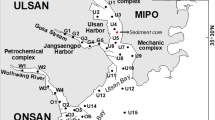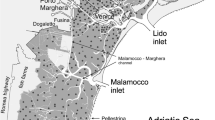Abstract
The concentrations and congener profiles of polychlorinated naphthalenes (PCNs) in surface sediment samples collected from the Yangtze and Yellow River Estuaries were investigated. PCN congeners (from MoCNs to OCN) were determined by isotope dilution/high-resolution gas chromatography/highresolution mass spectrometry (HRGC-HRMS). The total concentrations of PCNs were 34.3–303.0 pg/g (dry weight, dw) in the Yangtze Estuary samples and 6.2–408.0 pg/g (dw) in the Yellow River Estuary samples, which were lower compared with that in other sediments reported by previous studies. In addition, the remarkably different homologue or congener profiles of PCNs have been obtained in this study. Samples dominated with MoCNs to TrCNs might be attributed to atmospheric deposition and global fractionation, while in other samples taken from the surrounding industrial areas the enrichment of higher chlorinated homologues suggested that the industrial and human activities should be the main potential sources.
Similar content being viewed by others
References
Lerche D, van de Plassche E, Schwegler A, et al. Selecting chemical substances for the UN-ECE POP Protocol [J]. Chemosphere, 2002, 47(6): 617–630.
Kucklick J R, Helm P A. Advances in the environmental analysis of polychlorinated naphthalenes and toxaphene [J]. Anal Bioanal Chem, 2006, 386: 819–836.
Brinkman U A T, Reymer H G M. Polychlorinated naphthalenes [J]. J Chromatogr A, 1976, 127(3): 203–243.
Falandysz J. Polychlorinated naphthalenes: An environmental update [J]. Environ Pollut, 1998, 101(1): 77–90.
Wang D, Atkinson S, Hoover-Miller A, et al. Polychlorinated naphthalenes and coplanar polychlorinated biphenyls in tissues of harbor seals (Phoca vitulina) from the northern Gulf of Alaska [J]. Chemosphere, 2007, 67(10): 2044–2057.
Bidleman T F, Helm P, Braune B M, et al. Polychlorinated naphthalenes in polar environments — A review [J]. Sci Total Environ, 2010, 408(15): 2919–2935.
Yamashita N, Kannan K, Imagawa T, et al. Vertical profile of polychlorinated dibenzo-p-dioxins, dibenzofurans, naphthalenes, biphenyls, polycyclic aromatic hydrocarbons, and alkylphenols in a sediment core from Tokyo Bay, Japan [J]. Environ Sci Technol, 2000, 34(17): 3560–3567.
Imagawa T, Lee C W. Correlation of polychlorinated naphthalenes with polychlorinated dibenzofurans formed from waste incineration [J]. Chemosphere, 2001, 44(6): 1511–1520.
Noma Y, Yamamoto T, Giraud R, et al. Behavior of PCNs, PCDDs, PCDFs, and dioxin-like PCBs in the thermal destruction of wastes containing PCNs [J]. Chemosphere, 2006, 62(7): 1183–1195.
Eljarrat E, Caixach J, Jiménez B, et al. Polychlorinated naphthalenes in sediments from the Venice and Orbetello Lagoons, Italy [J]. Chemosphere, 1999, 38(8): 1901–1912.
Sakai S-I, Yamamoto T, Noma Y, et al. Formation and control of toxic polychlorinated compounds during incineration of wastes containing polychlorinated naphthalenes [J]. Environ Sci Technol, 2006, 40(7): 2247–2253.
Kannan K, Yamashita N, Imagawa T, et al. Polychlorinated naphthalenes and polychlorinated biphenyls in fishes from Michigan waters including the Great Lakes [J]. Environ Sci Technol, 2000, 34(4): 566–572.
Şişman T, Geyikoğlu F. The teratogenic effects of polychlorinated naphthalenes (PCNs) on early development of the zebrafish (Danio rerio) [J]. Environ Toxicol Phar, 2008, 25(1): 83–88.
Llobet J M, Falcó G, Bocio A, et al. Human exposure to polychlorinated naphthalenes through the consumption of edible marine species [J]. Chemosphere, 2007, 66(6): 1107–1113.
Jiang Q, Hanari N, Miyake Y, et al. Health risk assessment for polychlorinated biphenyls, polychlorinated dibenzo-pdioxins and dibenzofurans, and polychlorinated naphthalenes in seafood from Guangzhou and Zhoushan, China [J]. Environ Pollut, 2007, 148(1): 31–39.
Falandysz J, Strandberg L, Bergqvist P A, et al. Polychlorinated naphthalenes in sediment and biota from the Gdañsk Basin, Baltic Sea [J]. Environ Sci Technol, 1996, 30(11): 3266–3274.
Harner T, Shoeib M, Gouin T, et al. Polychlorinated naphthalenes in Great Lakes air: Assessing spatial trends and combustion inputs using PUF disk passive air samplers [J]. Environ Sci Technol, 2006, 40(17): 5333–5339.
Helm P A, Bidleman T F. Current combustion-related sources contribute to polychlorinated naphthalene and dioxin-like polychlorinated biphenyl levels and profiles in air in Toronto, Canada [J]. Environ Sci Technol, 2003, 37(6): 1075–1082.
Krauss M, Wilcke W. Polychlorinated naphthalenes in urban soils: Analysis, concentrations, and relation to other persistent organic pollutants [J]. Environ Pollut, 2003, 122(1): 75–89.
Wyrzykowska B, Hanari N, Orlikowska A, et al. Polychlorinated biphenyls and -naphthalenes in pine needles and soil from Poland—Concentrations and patterns in view of long-term environmental monitoring [J]. Chemosphere, 2007, 67(9): 1877–1886.
Järnberg U G, Asplund L T, Egebäck A L, et al. Polychlorinated naphthalene congener profiles in background sediments compared to a degraded Halowax 1014 technical mixture [J]. Environ Sci Technol, 1999, 33(1): 1–6.
Norén K, Meironyté D. Certain organochlorine and organobromine contaminants in Swedish human milk in perspective of past 20-30 years [J]. Chemosphere, 2000, 40(9–11): 1111–1123.
Kilanowicz A, Sitarek K, Skrzypinska-Gawrysiak M, et al. Prenatal developmental toxicity of polychlorinated naphthalenes (PCNs) in the rat [J]. Ecotox Environ Safe, 2011, 74(3): 504–512.
Helm P A, Bidleman T F, Li H H, et al. Seasonal and spatial variation of polychlorinated naphthalenes and non-/monoortho-substituted polychlorinated biphenyls in Arctic air. Environ Sci Technol, 2004, 38(21): 5514–5521.
Herbert B M J, Halsall C J, Villa S, et al. Polychlorinated naphthalenes in air and snow in the Norwegian Arctic: A local source or an eastern Arctic phenomenon [J]. Sci Total Environ, 2005, 342(1–3): 145–160.
Harner T, Kylin H, Bidleman T F, et al. Polychlorinated naphthalenes and coplanar polychlorinated biphenyls in arctic air [J]. Environ Sci Technol, 1998, 32(21): 3257–3265.
Lee S C, Harner T, Pozo K, et al. Polychlorinated naphthalenes in the global atmospheric passive sampling (GAPS) study [J]. Environ Sci Technol, 2007, 41(8): 2680–2687.
Pan J. Yang Y L, Xu Q, et al. PCBs, PCNs and PBDEs in sediments and mussels from Qingdao coastal sea in the frame of current circulations and influence of sewage sludge [J]. Chemosphere, 2007, 66(10): 1971–1982.
Harner T, Bidleman T F. Polychlorinated naphthalenes in urban air. Atmos [J]. Environ Sci Technol, 1997, 31(23): 4009–4016.
Schneider M, Stieglitz L, Will R, et al. Formation of polychlorinated naphthalenes on fly ash [J]. Chemosphere, 1998, 37(9): 2055–2070.
Abad E, Caixach J, Rivera J. Dioxin like compounds from municipal waste incinerator emissions: Assessment of the presence of polychlorinated naphthalenes [J]. Chemosphere, 1999, 38(1): 109–120.
Noma Y, Yamamoto T, Sakai S-I. Congener-specific composition of polychlorinated naphthalenes, coplanar PCBs, dibenzop-dioxins, and dibenzofurans in the Halowax series [J]. Environ Sci Technol, 2004, 38(6): 1675–1680.
Alcock R E, Sweetman A, Jones K C. Assessment of organic contanhnant fate in waste water treatment plants I: Selected compounds and physicochemical properties [J]. Chemosphere, 1999, 38(10): 2247–2262.
Kannan K, Imagawa T, Blankenship A L, et al. Isomer-specific analysis and toxic evaluation of polychlorinated naphthalenes in soil, sediment, and biota collected near the site of a former chlor-alkali plant [J]. Environ Sci Technol, 1998, 32(17): 2507–2514.
Shen M, Yu Y J, Zheng G J, et al. Polychlorinated biphenyls and polybrominated diphenyl ethers in surface sediments from the Yangtze River Delta [J]. Pollut Bull, 2006, 52(10): 1299–1304.
Lundgren K, Tysklind M, Ishaq R, et al. Flux estimates and sedimentation of polychlorinated naphthalenes in the northern part of the Baltic Sea [J]. Environ Pollut, 2003, 126(1): 93–105.
Marvin C, Alaee M, Painter S, et al. Persistent organic pollutants in Detroit River suspended sediments: Polychlorinated dibenzo-p-dioxins and dibenzofurans, dioxin-like polychlorinated biphenyls and polychlorinated naphthalenes [J]. Chemosphere, 2002, 49(2): 111–120.
Gevao B, Harner T, Jones K C. Sedimentary record of polychlorinated naphthalene concentrations and deposition fluxes in a dated lake core [J]. Environ Sci Technol, 1999, 34(1): 33–38.
Brack W, Kind T, Schrader S, et al. Polychlorinated naphthalenes in sediments from the industrial region of Bitterfeld [J]. Environ Pollut, 2003, 121(1): 81–85.
Pan X H, Tang J H, Chen Y J, et al. Polychlorinated naphthalenes (PCNs) in riverine and marine sediments of the Laizhou Bay area, north China [J]. Environ Pollut, 2011, 159(12): 3515–3521.
National Industrial Chemical Notification and Assessment Scheme. Polychlorinated naphthalenes [EB/OL]. [2002-04-12]. http://www.nicnas.gov.au/publications/car/other/S48PCNJuly02.pdf .
Meijer S N, Harner T, Helm P A, et al. Polychlorinated naphthalenes in U K soils: Time trends, markers of source, and equilibrium status [J]. Environ Sci Technol, 2001, 35(21): 4205–4213.
Author information
Authors and Affiliations
Corresponding author
Additional information
Foundation Item: Supported by the National Natural Science Foundation of China (20677070, 20621703)
Biography: GUO Li, female, Engineer, Ph. D., research direction: distribution, source, environmental behavior of persistent organic pollutants in environments.
Rights and permissions
About this article
Cite this article
Guo, L., Gao, L., Li, A. et al. Polychlorinated naphthalenes (PCNs) in surface sediments of the Yangtze and Yellow River Estuaries, China. Wuhan Univ. J. Nat. Sci. 18, 79–87 (2013). https://doi.org/10.1007/s11859-013-0897-9
Received:
Published:
Issue Date:
DOI: https://doi.org/10.1007/s11859-013-0897-9




